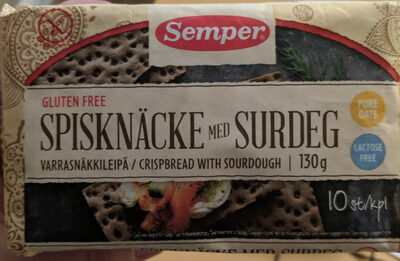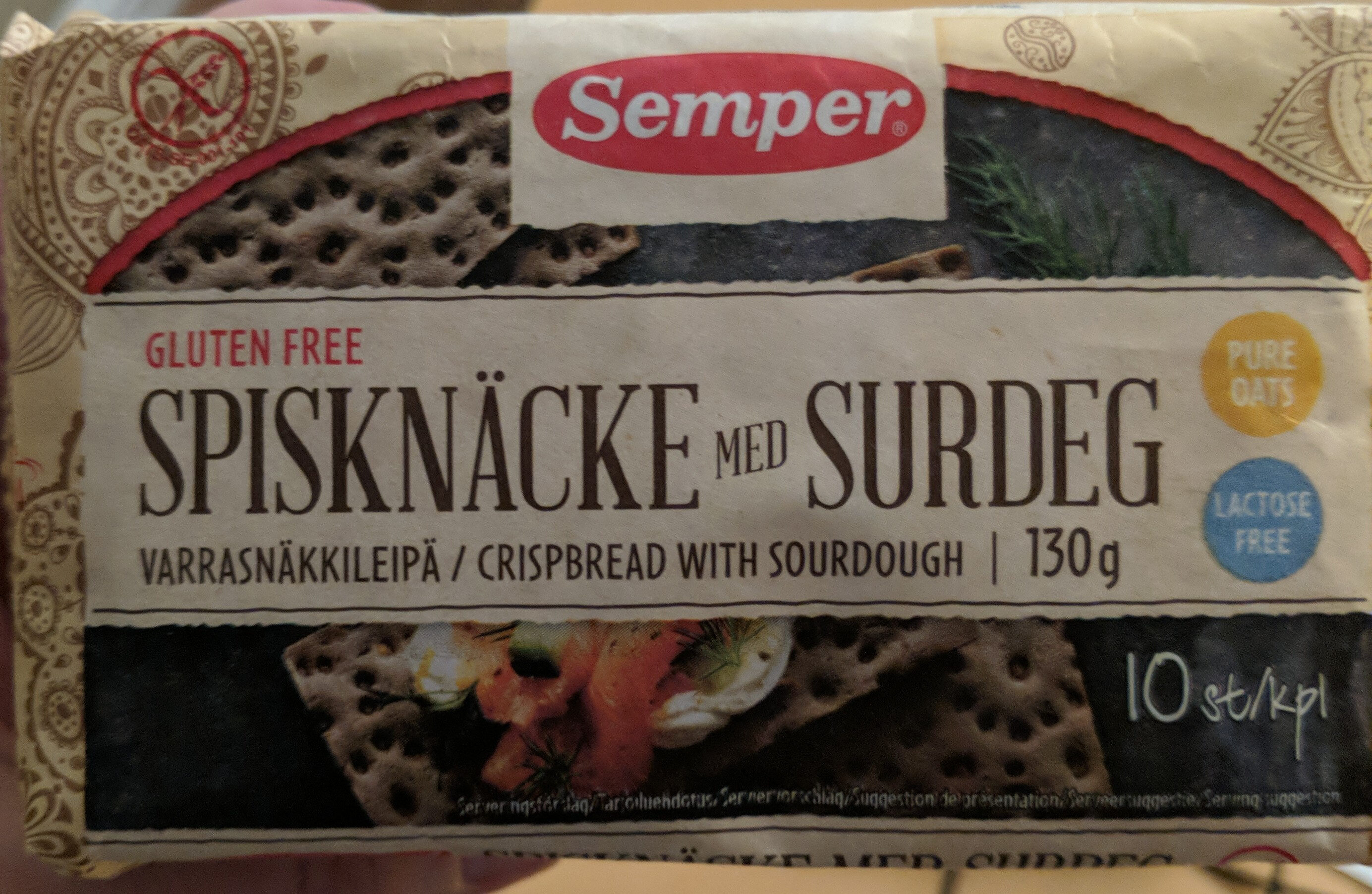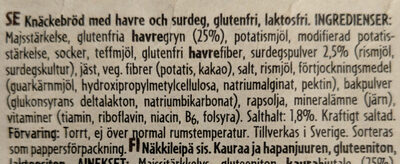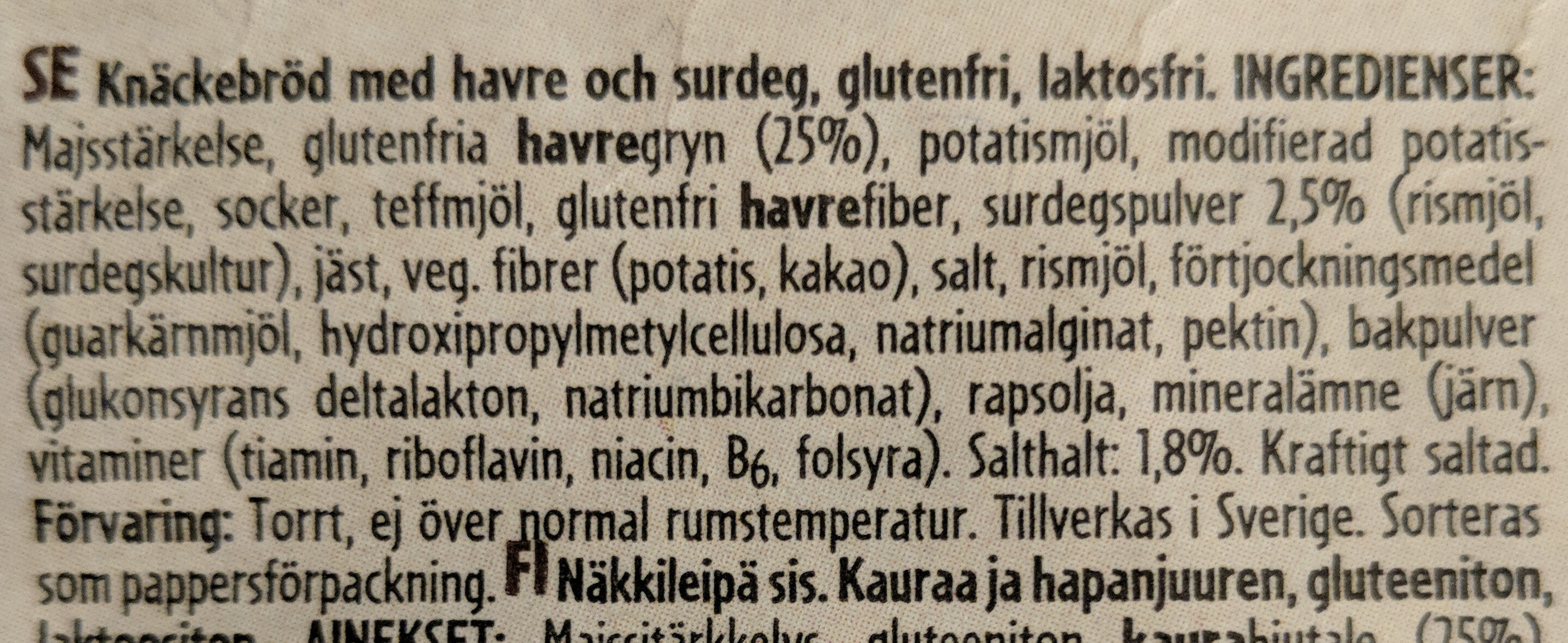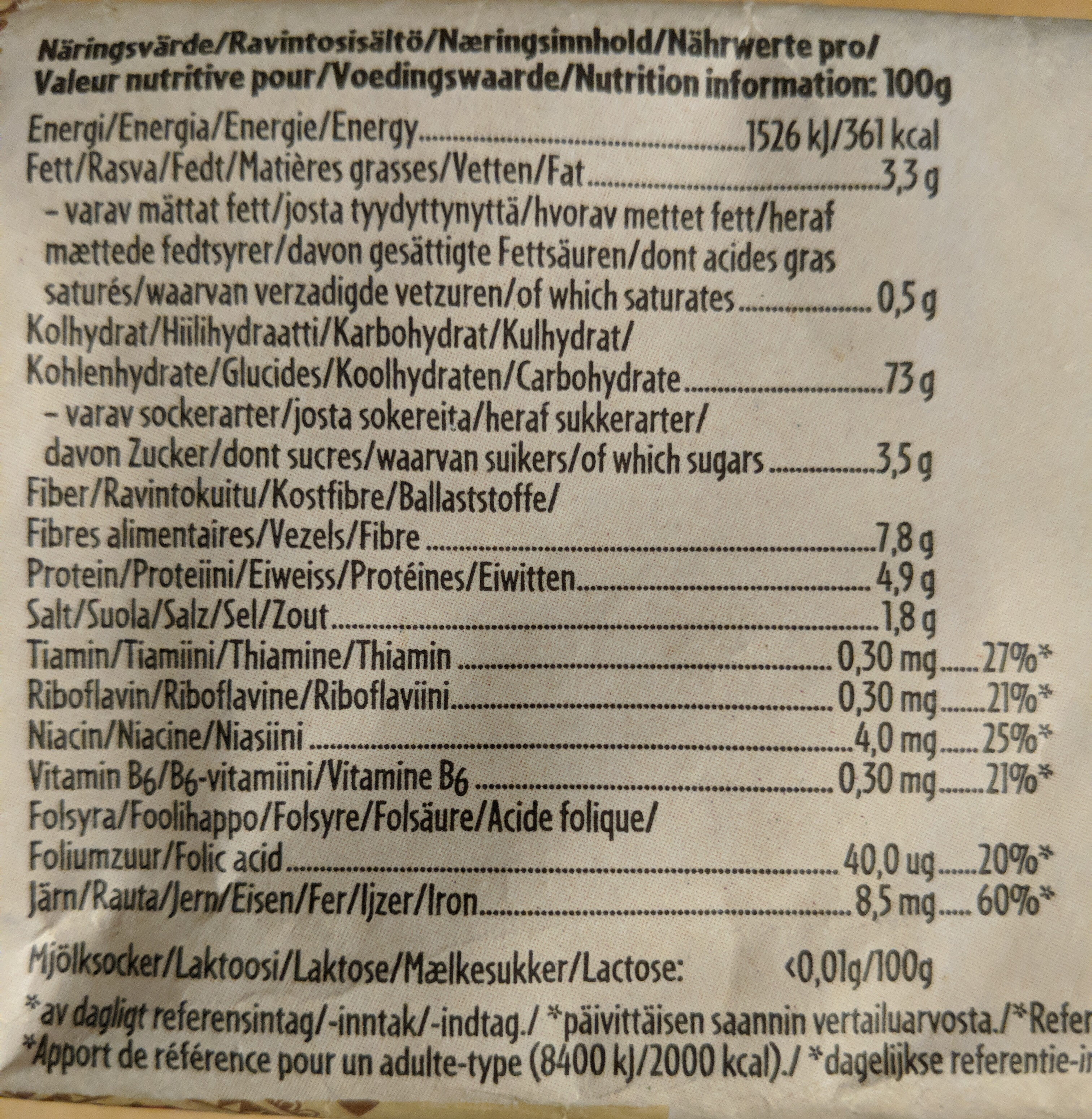Help us make food transparency the norm!
As a non-profit organization, we depend on your donations to continue informing consumers around the world about what they eat.
The food revolution starts with you!
Spisknäcke med surdeg - Semper - 130 g
Spisknäcke med surdeg - Semper - 130 g
This product page is not complete. You can help to complete it by editing it and adding more data from the photos we have, or by taking more photos using the app for Android or iPhone/iPad. Thank you!
×
Streckkod: 7310100602442 (EAN / EAN-13)
Kvantitet: 130 g
Förpackning: Papper
Varumärken: Semper
Kategorier: Växtbaserad mat och dryck, Växtbaserad mat, Spannmål och Potatisar, Bröd
Etiketter, certifieringar, utmärkelser: Glutenfri, Laktosfri
Länder där såld: Sverige
Matching with your preferences
Hälsa
Ingredienser
-
41 ingredienser
Majsstärkelse, glutenfria havregryn (25%), potatismjöl, modifierad potatis - stärkelse, socker, teffmjöl, glutenfri havrefiber, surdegspulver 2,5% (rismjöl, surdegskultur), jäst, veg. fibrer (potatis, kakao), salt, rismjöl, förtjockningsmedel (guarkärnmjöl, hydroxipropylmetylcellulosa, natriumalginat, pektin), bakpulver (glukonsyrans deltalakton, natriumbikarbonat), rapsolja, mineralämne (järn), vitaminer (tiamin, riboflavin, niacin, B6, folsyra). Salthalt: 1,8%. Kraftigt saltad. Förvaring: Torrt, ej över normal rumstemperatur. Tillverkas i Sverige. Sorteras som pappersförpackning.Allergener: Gluten
Food processing
-
Ultra processed foods
Elements that indicate the product is in the 4 - Ultra bearbetade livsmedel och drycker group:
- Tillsats: E401 - Natriumalginat
- Tillsats: E412 - Guarkärnmjöl
- Tillsats: E464 - Hydroxipropylmetylcellulosa
- Ingrediens: Förtjockningsmedel
Food products are classified into 4 groups according to their degree of processing:
- Obearbetade eller minimalt bearbetade livsmedel
- Bearbetade kulinariska ingredienser
- Halvfabrikat
- Ultra processed foods
The determination of the group is based on the category of the product and on the ingredients it contains.
Tillsatser
-
E412 - Guarkärnmjöl
Guar gum: Guar gum, also called guaran, is a galactomannan polysaccharide extracted from guar beans that has thickening and stabilizing properties useful in the food, feed and industrial applications. The guar seeds are mechanically dehusked, hydrated, milled and screened according to application. It is typically produced as a free-flowing, off-white powder.Källa: Wikipedia (Engelska)
-
E440a - Pektin
Pectin: Pectin -from Ancient Greek: πηκτικός pēktikós, "congealed, curdled"- is a structural heteropolysaccharide contained in the primary cell walls of terrestrial plants. It was first isolated and described in 1825 by Henri Braconnot. It is produced commercially as a white to light brown powder, mainly extracted from citrus fruits, and is used in food as a gelling agent, particularly in jams and jellies. It is also used in dessert fillings, medicines, sweets, as a stabilizer in fruit juices and milk drinks, and as a source of dietary fiber.Källa: Wikipedia (Engelska)
-
E464 - Hydroxipropylmetylcellulosa
Hypromellose: Hypromellose -INN-, short for hydroxypropyl methylcellulose -HPMC-, is a semisynthetic, inert, viscoelastic polymer used as eye drops, as well as an excipient and controlled-delivery component in oral medicaments, found in a variety of commercial products.As a food additive, hypromellose is an emulsifier, thickening and suspending agent, and an alternative to animal gelatin. Its Codex Alimentarius code -E number- is E464.Källa: Wikipedia (Engelska)
-
E500 - Natriumkarbonater
Sodium carbonate: Sodium carbonate, Na2CO3, -also known as washing soda, soda ash and soda crystals, and in the monohydrate form as crystal carbonate- is the water-soluble sodium salt of carbonic acid. It most commonly occurs as a crystalline decahydrate, which readily effloresces to form a white powder, the monohydrate. Pure sodium carbonate is a white, odorless powder that is hygroscopic -absorbs moisture from the air-. It has a strongly alkaline taste, and forms a moderately basic solution in water. Sodium carbonate is well known domestically for its everyday use as a water softener. Historically it was extracted from the ashes of plants growing in sodium-rich soils, such as vegetation from the Middle East, kelp from Scotland and seaweed from Spain. Because the ashes of these sodium-rich plants were noticeably different from ashes of timber -used to create potash-, they became known as "soda ash". It is synthetically produced in large quantities from salt -sodium chloride- and limestone by a method known as the Solvay process. The manufacture of glass is one of the most important uses of sodium carbonate. Sodium carbonate acts as a flux for silica, lowering the melting point of the mixture to something achievable without special materials. This "soda glass" is mildly water-soluble, so some calcium carbonate is added to the melt mixture to make the glass produced insoluble. This type of glass is known as soda lime glass: "soda" for the sodium carbonate and "lime" for the calcium carbonate. Soda lime glass has been the most common form of glass for centuries. Sodium carbonate is also used as a relatively strong base in various settings. For example, it is used as a pH regulator to maintain stable alkaline conditions necessary for the action of the majority of photographic film developing agents. It acts as an alkali because when dissolved in water, it dissociates into the weak acid: carbonic acid and the strong alkali: sodium hydroxide. This gives sodium carbonate in solution the ability to attack metals such as aluminium with the release of hydrogen gas.It is a common additive in swimming pools used to raise the pH which can be lowered by chlorine tablets and other additives which contain acids. In cooking, it is sometimes used in place of sodium hydroxide for lyeing, especially with German pretzels and lye rolls. These dishes are treated with a solution of an alkaline substance to change the pH of the surface of the food and improve browning. In taxidermy, sodium carbonate added to boiling water will remove flesh from the bones of animal carcasses for trophy mounting or educational display. In chemistry, it is often used as an electrolyte. Electrolytes are usually salt-based, and sodium carbonate acts as a very good conductor in the process of electrolysis. In addition, unlike chloride ions, which form chlorine gas, carbonate ions are not corrosive to the anodes. It is also used as a primary standard for acid-base titrations because it is solid and air-stable, making it easy to weigh accurately.Källa: Wikipedia (Engelska)
-
E500ii - Natriumvätekarbonat
Sodium carbonate: Sodium carbonate, Na2CO3, -also known as washing soda, soda ash and soda crystals, and in the monohydrate form as crystal carbonate- is the water-soluble sodium salt of carbonic acid. It most commonly occurs as a crystalline decahydrate, which readily effloresces to form a white powder, the monohydrate. Pure sodium carbonate is a white, odorless powder that is hygroscopic -absorbs moisture from the air-. It has a strongly alkaline taste, and forms a moderately basic solution in water. Sodium carbonate is well known domestically for its everyday use as a water softener. Historically it was extracted from the ashes of plants growing in sodium-rich soils, such as vegetation from the Middle East, kelp from Scotland and seaweed from Spain. Because the ashes of these sodium-rich plants were noticeably different from ashes of timber -used to create potash-, they became known as "soda ash". It is synthetically produced in large quantities from salt -sodium chloride- and limestone by a method known as the Solvay process. The manufacture of glass is one of the most important uses of sodium carbonate. Sodium carbonate acts as a flux for silica, lowering the melting point of the mixture to something achievable without special materials. This "soda glass" is mildly water-soluble, so some calcium carbonate is added to the melt mixture to make the glass produced insoluble. This type of glass is known as soda lime glass: "soda" for the sodium carbonate and "lime" for the calcium carbonate. Soda lime glass has been the most common form of glass for centuries. Sodium carbonate is also used as a relatively strong base in various settings. For example, it is used as a pH regulator to maintain stable alkaline conditions necessary for the action of the majority of photographic film developing agents. It acts as an alkali because when dissolved in water, it dissociates into the weak acid: carbonic acid and the strong alkali: sodium hydroxide. This gives sodium carbonate in solution the ability to attack metals such as aluminium with the release of hydrogen gas.It is a common additive in swimming pools used to raise the pH which can be lowered by chlorine tablets and other additives which contain acids. In cooking, it is sometimes used in place of sodium hydroxide for lyeing, especially with German pretzels and lye rolls. These dishes are treated with a solution of an alkaline substance to change the pH of the surface of the food and improve browning. In taxidermy, sodium carbonate added to boiling water will remove flesh from the bones of animal carcasses for trophy mounting or educational display. In chemistry, it is often used as an electrolyte. Electrolytes are usually salt-based, and sodium carbonate acts as a very good conductor in the process of electrolysis. In addition, unlike chloride ions, which form chlorine gas, carbonate ions are not corrosive to the anodes. It is also used as a primary standard for acid-base titrations because it is solid and air-stable, making it easy to weigh accurately.Källa: Wikipedia (Engelska)
-
E575 - Glukonsyrans deltalakton
Glucono delta-lactone: Glucono delta-lactone -GDL-, also known as gluconolactone, is a food additive with the E number E575 used as a sequestrant, an acidifier, or a curing, pickling, or leavening agent. It is a lactone of D-gluconic acid. Pure GDL is a white odorless crystalline powder. GDL has been marketed for use in feta cheese. GDL is neutral, but hydrolyses in water to gluconic acid which is acidic, adding a tangy taste to foods, though it has roughly a third of the sourness of citric acid. It is metabolized to 6-phospho-D-gluconate; one gram of GDL yields roughly the same amount of metabolic energy as one gram of sugar. Upon addition to water, GDL is partially hydrolysed to gluconic acid, with the balance between the lactone form and the acid form established as a chemical equilibrium. The rate of hydrolysis of GDL is increased by heat and high pH.The yeast Saccharomyces bulderi can be used to ferment gluconolactone to ethanol and carbon dioxide. The pH value greatly affects culture growth. Gluconolactone at 1 or 2% in a mineral media solution causes the pH to drop below 3.It is also a complete inhibitor of the enzyme amygdalin beta-glucosidase at concentrations of 1 mM.Källa: Wikipedia (Engelska)
Ingrediensanalys
-
Palmolja innehåll okänt
Okända ingredienser: Glutenfria-havregryn, Modifierad-potatis, Surdegspulver, Surdegskultur, Tiamin, Salthalt, Kraftigt-saltad, Förvaring, Torrt, Ej-över-normal-rumstemperatur, Tillverkas-i-sverige, Sorteras-som-pappersförpackningVissa ingredienser kunde inte kännas igen.
Vi behöver din hjälp!
You can help us recognize more ingredients and better analyze the list of ingredients for this product and others:
- Edit this product page to correct spelling mistakes in the ingredients list, and/or to remove ingredients in other languages and sentences that are not related to the ingredients.
- Add new entries, synonyms or translations to our multilingual lists of ingredients, ingredient processing methods, and labels.
If you would like to help, join the #ingredients channel on our Slack discussion space and/or learn about ingredients analysis on our wiki. Thank you!
-
Vegansk status okänd
Okända ingredienser: Glutenfria-havregryn, Modifierad-potatis, Surdegspulver, Surdegskultur, Järn, Tiamin, Folsyra, Salthalt, Kraftigt-saltad, Förvaring, Torrt, Ej-över-normal-rumstemperatur, Tillverkas-i-sverige, Sorteras-som-pappersförpackningVissa ingredienser kunde inte kännas igen.
Vi behöver din hjälp!
You can help us recognize more ingredients and better analyze the list of ingredients for this product and others:
- Edit this product page to correct spelling mistakes in the ingredients list, and/or to remove ingredients in other languages and sentences that are not related to the ingredients.
- Add new entries, synonyms or translations to our multilingual lists of ingredients, ingredient processing methods, and labels.
If you would like to help, join the #ingredients channel on our Slack discussion space and/or learn about ingredients analysis on our wiki. Thank you!
-
Vegetarisk status okänd
Okända ingredienser: Glutenfria-havregryn, Modifierad-potatis, Surdegspulver, Surdegskultur, Järn, Tiamin, Folsyra, Salthalt, Kraftigt-saltad, Förvaring, Torrt, Ej-över-normal-rumstemperatur, Tillverkas-i-sverige, Sorteras-som-pappersförpackningVissa ingredienser kunde inte kännas igen.
Vi behöver din hjälp!
You can help us recognize more ingredients and better analyze the list of ingredients for this product and others:
- Edit this product page to correct spelling mistakes in the ingredients list, and/or to remove ingredients in other languages and sentences that are not related to the ingredients.
- Add new entries, synonyms or translations to our multilingual lists of ingredients, ingredient processing methods, and labels.
If you would like to help, join the #ingredients channel on our Slack discussion space and/or learn about ingredients analysis on our wiki. Thank you!
-
Details of the analysis of the ingredients
Vi behöver din hjälp!
Vissa ingredienser kunde inte kännas igen.
Vi behöver din hjälp!
You can help us recognize more ingredients and better analyze the list of ingredients for this product and others:
- Edit this product page to correct spelling mistakes in the ingredients list, and/or to remove ingredients in other languages and sentences that are not related to the ingredients.
- Add new entries, synonyms or translations to our multilingual lists of ingredients, ingredient processing methods, and labels.
If you would like to help, join the #ingredients channel on our Slack discussion space and/or learn about ingredients analysis on our wiki. Thank you!
sv: Majsstärkelse, glutenfria havregryn 25%, potatismjöl, modifierad potatis, stärkelse, socker, teffmjöl, havrefiber, surdegspulver 2.5% (rismjöl, surdegskultur), jäst, vegetabilisk fibrer (potatis, kakao), salt, rismjöl, förtjockningsmedel (guarkärnmjöl, hydroxipropylmetylcellulosa, natriumalginat, pektin), bakpulver (glukonsyrans deltalakton, natriumbikarbonat), rapsolja, mineralämne (järn), vitaminer (tiamin, riboflavin, niacin, B6, folsyra), Salthalt 1.8% (Kraftigt saltad, Förvaring), Torrt, ej över normal rumstemperatur, Tillverkas i Sverige, Sorteras som pappersförpackning- Majsstärkelse -> en:corn-starch - vegan: yes - vegetarian: yes - ciqual_food_code: 9510
- glutenfria havregryn -> sv:glutenfria-havregryn - percent: 25
- potatismjöl -> en:potato-flour - vegan: yes - vegetarian: yes - ciqual_food_code: 4003
- modifierad potatis -> sv:modifierad-potatis
- stärkelse -> en:starch - vegan: yes - vegetarian: yes - ciqual_proxy_food_code: 9510
- socker -> en:sugar - vegan: yes - vegetarian: yes - ciqual_proxy_food_code: 31016
- teffmjöl -> en:teff-flour - vegan: yes - vegetarian: yes - ciqual_proxy_food_code: 9410
- havrefiber -> en:oat-fibre - labels: en:no-gluten - vegan: yes - vegetarian: yes - ciqual_food_code: 9310
- surdegspulver -> sv:surdegspulver - percent: 2.5
- rismjöl -> en:rice-flour - vegan: yes - vegetarian: yes - ciqual_food_code: 9520
- surdegskultur -> sv:surdegskultur
- jäst -> en:yeast - vegan: yes - vegetarian: yes - ciqual_proxy_food_code: 11009
- vegetabilisk fibrer -> en:vegetable-fiber - vegan: yes - vegetarian: yes
- potatis -> en:potato - vegan: yes - vegetarian: yes - ciqual_food_code: 4003
- kakao -> en:cocoa - vegan: yes - vegetarian: yes - ciqual_proxy_food_code: 18100
- salt -> en:salt - vegan: yes - vegetarian: yes - ciqual_food_code: 11058
- rismjöl -> en:rice-flour - vegan: yes - vegetarian: yes - ciqual_food_code: 9520
- förtjockningsmedel -> en:thickener
- guarkärnmjöl -> en:e412 - vegan: yes - vegetarian: yes
- hydroxipropylmetylcellulosa -> en:e464 - vegan: yes - vegetarian: yes
- natriumalginat -> en:e401 - vegan: yes - vegetarian: yes
- pektin -> en:e440a - vegan: yes - vegetarian: yes
- bakpulver -> en:baking-powder - vegan: yes - vegetarian: yes - ciqual_food_code: 11046
- glukonsyrans deltalakton -> en:e575 - vegan: yes - vegetarian: yes
- natriumbikarbonat -> en:e500ii - vegan: yes - vegetarian: yes
- rapsolja -> en:rapeseed-oil - vegan: yes - vegetarian: yes - from_palm_oil: no - ciqual_food_code: 17130
- mineralämne -> en:minerals
- järn -> en:iron
- vitaminer -> en:vitamins - vegan: yes - vegetarian: yes
- tiamin -> sv:tiamin
- riboflavin -> en:e101 - vegan: maybe - vegetarian: yes
- niacin -> en:e375 - vegan: maybe - vegetarian: maybe
- B6 -> en:vitamin-b6 - vegan: yes - vegetarian: yes
- folsyra -> en:folic-acid
- Salthalt -> sv:salthalt - percent: 1.8
- Kraftigt saltad -> sv:kraftigt-saltad
- Förvaring -> sv:förvaring
- Torrt -> sv:torrt
- ej över normal rumstemperatur -> sv:ej-över-normal-rumstemperatur
- Tillverkas i Sverige -> sv:tillverkas-i-sverige
- Sorteras som pappersförpackning -> sv:sorteras-som-pappersförpackning
Näring
-
Average nutritional quality
⚠ ️Warning: the amount of fruits, vegetables and nuts is not specified on the label, it was estimated from the list of ingredients: 0This product is not considered a beverage for the calculation of the Nutri-Score.
Positiva poäng: 5
- Proteiner: 3 / 5 (värde: 4.9, avrundat värde: 4.9)
- Fiber: 5 / 5 (värde: 7.8, avrundat värde: 7.8)
- Frukt, grönsaker, nötter och raps- / valnöt- / olivoljor: 0 / 5 (värde: 0, avrundat värde: 0)
Negativa poäng: 11
- Energi: 4 / 10 (värde: 1510, avrundat värde: 1510)
- Socker: 0 / 10 (värde: 3.5, avrundat värde: 3.5)
- Mättat fett: 0 / 10 (värde: 0.5, avrundat värde: 0.5)
- Natrium: 7 / 10 (värde: 720, avrundat värde: 720)
The points for proteins are not counted because the negative points are greater or equal to 11.
Näringsvärde: (11 - 5)
Nutri-Score:
-
Näringsvärden
-
Fett i måttlig kvantitet (3.3%)
What you need to know- A high consumption of fat, especially saturated fats, can raise cholesterol, which increases the risk of heart diseases.
Recommendation: Limit the consumption of fat and saturated fat- Choose products with lower fat and saturated fat content.
-
Mättat fett i låg kvantitet (0.5%)
What you need to know- A high consumption of fat, especially saturated fats, can raise cholesterol, which increases the risk of heart diseases.
Recommendation: Limit the consumption of fat and saturated fat- Choose products with lower fat and saturated fat content.
-
Sockerarter i låg kvantitet (3.5%)
What you need to know- A high consumption of sugar can cause weight gain and tooth decay. It also augments the risk of type 2 diabetes and cardio-vascular diseases.
Recommendation: Limit the consumption of sugar and sugary drinks- Sugary drinks (such as sodas, fruit beverages, and fruit juices and nectars) should be limited as much as possible (no more than 1 glass a day).
- Choose products with lower sugar content and reduce the consumption of products with added sugars.
-
Salt i hög kvantitet (1.8%)
What you need to know- A high consumption of salt (or sodium) can cause raised blood pressure, which can increase the risk of heart disease and stroke.
- Many people who have high blood pressure do not know it, as there are often no symptoms.
- Most people consume too much salt (on average 9 to 12 grams per day), around twice the recommended maximum level of intake.
Recommendation: Limit the consumption of salt and salted food- Reduce the quantity of salt used when cooking, and don't salt again at the table.
- Limit the consumption of salty snacks and choose products with lower salt content.
-
-
Näringsfakta
Näringsfakta Som såld
för 100 g / 100 mlSom såld
per portion (100g)Compared to: Bröd Energi 1 510 kj
(361 kcal)1 510 kj
(361 kcal)+20 % Fett 3,3 g 3,3 g −24 % Mättat fett 0,5 g 0,5 g −31 % Kolhydrat 73 g 73 g +45 % Sockerarter 3,5 g 3,5 g −17 % Fiber 7,8 g 7,8 g +15 % Protein 4,9 g 4,9 g −47 % Salt 1,8 g 1,8 g +71 % Fruits‚ vegetables‚ nuts and rapeseed‚ walnut and olive oils (estimate from ingredients list analysis) 0 % 0 %
Miljö
-
Eco-score ej beräknad - Okänd miljöpåverkan
Vi kunde inte beräkna Eco-Score av denna produkt eftersom det saknas vissa data, kan du hjälpa till att slutföra det?Could you add a precise product category so that we can compute the Eco-Score? Lägg till en kategori
Förpackning
-
Packaging with a low impact
-
Packaging parts
(Papper)
-
Packaging materials
Material % Packaging weight Packaging weight per 100 g of product Paper or cardboard
-
Transportation
-
Origins of ingredients
Missing origins of ingredients information
⚠ ️ The origins of the ingredients of this product are not indicated.
If they are indicated on the packaging, you can modify the product sheet and add them.
If you are the manufacturer of this product, you can send us the information with our free platform for producers.Add the origins of ingredients for this product Add the origins of ingredients for this product
Report a problem
-
Incomplete or incorrect information?
Category, labels, ingredients, allergens, nutritional information, photos etc.
If the information does not match the information on the packaging, please complete or correct it. Open Food Facts is a collaborative database, and every contribution is useful for all.
Datakällor
Produkt tillagd den av horizone
Senast ändrad produktsida på av akitainu.
Produktsida också redigerad av openfoodfacts-contributors, roboto-app.
